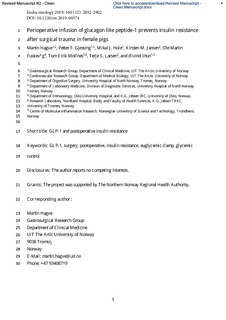| dc.contributor.author | Hagve, Martin Iversen | |
| dc.contributor.author | Gjessing, Petter Fosse | |
| dc.contributor.author | Hole, Mikal Jacob | |
| dc.contributor.author | Jansen, Kirsten M | |
| dc.contributor.author | Fuskevåg, Ole Martin | |
| dc.contributor.author | Mollnes, Tom Eirik | |
| dc.contributor.author | Larsen, Terje S | |
| dc.contributor.author | Irtun, Øivind | |
| dc.date.accessioned | 2020-02-18T07:21:10Z | |
| dc.date.available | 2020-02-18T07:21:10Z | |
| dc.date.created | 2019-12-05T08:48:46Z | |
| dc.date.issued | 2019 | |
| dc.identifier.citation | Endocrinology. 2019, 160 (12), 2892-2902. | nb_NO |
| dc.identifier.issn | 0013-7227 | |
| dc.identifier.uri | http://hdl.handle.net/11250/2642110 | |
| dc.description.abstract | Insulin resistance is an independent negative predictor of outcome after elective surgery and increases mortality among surgical patients in intensive care. The incretin hormone glucagon-like peptide-1 (GLP-1) potentiates glucose-induced insulin release from the pancreas but may also increase insulin sensitivity in skeletal muscle and directly suppress hepatic glucose release. Here, we investigated whether a perioperative infusion of GLP-1 could counteract the development of insulin resistance after surgery. Pigs were randomly assigned to three groups; surgery/control, surgery/GLP-1, and sham/GLP-1. Both surgery groups underwent major abdominal surgery. Whole-body glucose disposal (WGD) and endogenous glucose release (EGR) were assessed preoperatively and postoperatively using D-[6,6-2H2]-glucose infusion in combination with hyperinsulinemic euglycemic step-clamping. In the surgery/control group, peripheral insulin sensitivity (i.e., WGD) was reduced by 44% relative to preoperative conditions, whereas the corresponding decline was only 9% for surgery/GLP-1 (P < 0.05). Hepatic insulin sensitivity (i.e., EGR) remained unchanged in the surgery/control group but was enhanced after GLP-1 infusion in both surgery and sham animals (40% and 104%, respectively, both P < 0.05). Intraoperative plasma glucose increased in surgery/control (∼20%) but remained unchanged in both groups receiving GLP-1 (P < 0.05). GLP-1 diminished an increase in postoperative glucagon levels but did not affect skeletal muscle glycogen or insulin signaling proteins after surgery. We show that GLP-1 improves intraoperative glycemic control, diminishes peripheral insulin resistance after surgery, and suppresses EGR. This study supports the use of GLP-1 to prevent development of postoperative insulin resistance. | nb_NO |
| dc.language.iso | eng | nb_NO |
| dc.publisher | Oxford University Press (OUP) | nb_NO |
| dc.title | Perioperative infusion of glucagon-like peptide-1 prevents insulin resistance after surgical trauma in female pigs | nb_NO |
| dc.type | Journal article | nb_NO |
| dc.type | Peer reviewed | nb_NO |
| dc.description.version | acceptedVersion | nb_NO |
| dc.source.pagenumber | 2892-2902 | nb_NO |
| dc.source.volume | 160 | nb_NO |
| dc.source.journal | Endocrinology | nb_NO |
| dc.source.issue | 12 | nb_NO |
| dc.identifier.doi | 10.1210/en.2019-00374 | |
| dc.identifier.cristin | 1756929 | |
| dc.description.localcode | Locked until 7.10.2020 due to copyright restrictions. This is a pre-copyedited, author-produced version of an article accepted for publication in [journal] following peer review. The version of record is available online at: [insert URL and DOI of the article on the OUP website]. | nb_NO |
| cristin.unitcode | 194,65,15,0 | |
| cristin.unitname | Institutt for klinisk og molekylær medisin | |
| cristin.ispublished | true | |
| cristin.fulltext | postprint | |
| cristin.qualitycode | 2 | |
